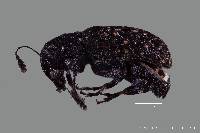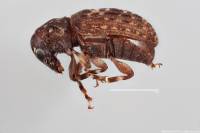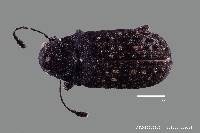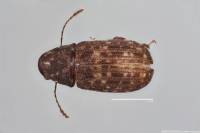Go to Encyclopedia of Life...
Blackish brown, alternate elytral interspaces tesselated with black and yellowish spots. Beak feebly arcuately emarginate at apex. Antennae slender, dark, last joint paler at apex, first joint shorter and stouter than second, which again is stouter and about three-fourths as long as third, three to seven gradually decreasing in length, the last four joints forming a loose club, joints eight and nine of equal length, but the former narrower, joint ten transverse. Prothorax broader at base than long; carina not quite basal and feebly rounded, recurved at sides and gradually disappearing towards middle; color black, with an apical median pale spot. Elytra nearly three times as long as the thorax, striate, striae rather closely punctate; alternate interspaces wider and slightly convex, tesselated with black and pale spots; acutellum white. Body beneath sparsely clothed with greyish pubescence. Legs black, tibiae near base and first joint of tarsi at base pale; second and third tarsal joints scarcely wider than first. Length 6.50 mm.
Huachuca Mts., Arizona, collected by Mr. Gustav Beyer, to whom I am indebted for the single male.
According to the description, this species must be near alternans from South America, but the legs are differently colored and the eighth antennal joint is not four times as long as apically broad. From our North American species it will easily be recognized by the markings of the elytra and by the form of the eighth antennal joint, which is similar to that of moestus. The third ventral segment is feebly convex at middle. The males of mixtus have on the third ventral segment a small tubercle at middle, and the eyes are emarginate, but very feebly.
































